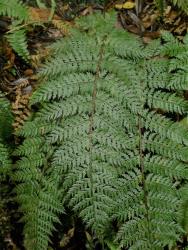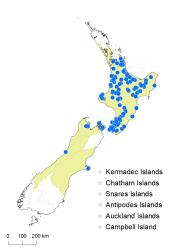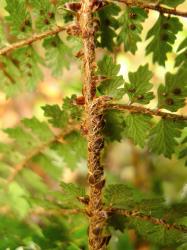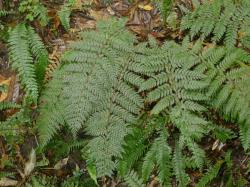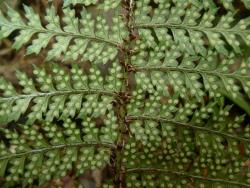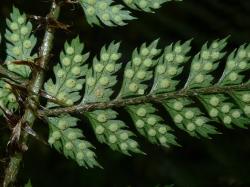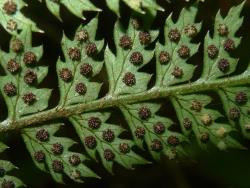- Taxon
- Gallery
- ≡ Polypodium sylvaticum Colenso, Tasmanian J. Nat. Sci. 2: 163 (1845) nom. illeg., non Polypodium sylvaticum Schkuhr 1809
- ≡ Polystichum vestitum subsp. sylvaticum (Diels) C.Chr., Index Filic. 588 (1906)
- ≡ Aspidium aculeatum var. sylvaticum (Colenso) Cheeseman, Man. New Zealand Fl. 998 (1906) nom. illeg.
- ≡ Polystichum aculeatum var. sylvaticum (Diels) Domin, Biblioth. Bot. 20(85): 56 (1913) – as silvaticum
Rhizomes erect, densely scaly. Rhizome scales narrowly ovate, 7.5–25 mm long, 1.2–2.3 mm wide, some bicolorous with dark centres and pale margins, others uniformly pale brown, margins entire or with a few cilia. Fronds 150–800 mm long. Stipes 50–330 mm long, pale or yellow-brown, densely scaly throughout; scales narrowly ovate to ovate, bicolorous with dark centres and pale margins, or uniformly pale brown, apices acuminate, margins entire or ciliate. Rachises pale or yellow-brown, sulcate, narrowly winged only at distal end, abundantly scaly; scales on both surfaces narrowly ovate and bicolorous, and narrowly ovate to ± linear and pale brown. Laminae 2-pinnate or rarely 2-pinnate-pinnatifid, elliptic or narrowly elliptic, 110–630 mm long, 45–220 mm wide, dark green adaxially, paler green abaxially, coriaceous, bearing abundant pale brown scales on abaxial costae and lamina surfaces, sparser on adaxial surfaces. Primary pinnae in 13–32 pairs below pinnatifid apex, widely spaced, narrowly ovate; the longest at or near the middle, 25–120 mm long, 10–32 mm wide, apices acuminate, bases stalked; costae usually winged throughout, or only in distal half in largest fronds. Secondary pinnae decreasing in length only near the primary pinna apices; the longest secondary pinnae elliptic or ovate, 7–20 mm long, 4–7 mm wide, apices sharply pointed, margins sharply and often deeply serrate, bases stalked. Sori round, medial or nearer margin than costa, sometimes protected by a few small scales; indusia absent.
Polystichum sylvaticum is distinguished by the scales at the stipe/rachis junction, many of which are markedly bicolorous, with dark centres and pale margins. Indusia are absent, and the sori are protected only by a few small scales. The laminae are elliptic, dark green on the adaxial surface, and the primary costae are narrowly winged throughout their length except in the largest fronds. The species is likely to be confused only with P. vestitum, which also has bicolorous scales, but has well-formed indusia, and narrow wings on the primary costae only at their distal end. Its laminae are relatively long and narrow with ± parallel sides, and dark shiny green on the adaxial surface. P. sylvaticum is distinguished from most of the naturalised species by its lack of bulbils, and is clearly distinct from P. cystostegia, which has inflated indusia and is largely confined to alpine areas.
North Island: Auckland, Volcanic Plateau, Gisborne, Taranaki, Southern North Island.
South Island: Western Nelson, Sounds-Nelson, Westland, Canterbury.
Altitudinal range: 20–985 m.
Polystichum sylvaticum occurs in lowland and montane forest of the North Island from Coromandel and the Hunua Ranges to Wellington, reaching 960 m near East Cape and 985 m on Mt Taranaki. In the South Island it occurs in north-west Nelson and the Marlborough Sounds, with outlying populations at Hokitika and on Banks Peninsula. It reaches 450 m on D’Urville Island and in the Tākaka Hill area.
Polystichum sylvaticum occurs in damp, dark, podocarp and broadleaved forest. It grows on hillsides, clay banks, tracksides, river banks, alluvial terraces, damp rock faces, and in wet gullies and seepages.
There is evidence that Polystichum sylvaticum hybridises with P. vestitum (Perrie et al. 2003).
n = c. 82 (Brownsey in Dawson et al. 2000).
The name Polypodium sylvaticum, as described by Colenso (1845), is illegitimate (Art. 6.4), being a later homonym of P. sylvaticum Schkuhr (1809). Diels (in Engler & Prantl 1898–1902) intended to create a new combination in Polystichum by writing “P. silvaticum (Colenso als Polypodium) Diels”. However, Diels’s name is a new name (Art. 6.12a, 6.14), validated by Colenso’s description of Polypodium sylvaticum. Diels was obligated to adopt Colenso’s epithet with the original spelling (Art. 60.1, 60.2), unless he explicitly changed the spelling and stated that he was making a correction; but there is no evidence of such intent. The correct name and spelling for this species is Polystichum sylvaticum Diels in Engler & Prantl, Nat. Pflanzenfam. 1(4): 192, 1899 (‘silvaticum’), not P. silvaticum (Colenso) Diels. (In making this determination we are very grateful for extensive and valuable discussion with John McNeill, Royal Botanic Gardens, Edinburgh).



